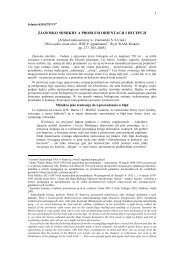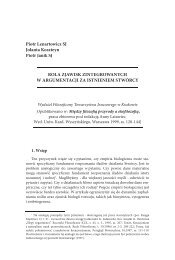the body-mind dichotomy a problem or artifact? - Piotr Lenartowicz SJ
the body-mind dichotomy a problem or artifact? - Piotr Lenartowicz SJ
the body-mind dichotomy a problem or artifact? - Piotr Lenartowicz SJ
Create successful ePaper yourself
Turn your PDF publications into a flip-book with our unique Google optimized e-Paper software.
15<br />
(ii)<br />
modified in many aspects. One of those aspects means a change <strong>or</strong> an enrichment<br />
of <strong>the</strong> <strong>or</strong>iginal encrypted message. Any possible inf<strong>or</strong>mational feed-back<br />
to ano<strong>the</strong>r place in <strong>the</strong> DNA molecule necessarily does imply a highly selective,<br />
complex system of control in time, in space and in <strong>the</strong> quality of <strong>the</strong> editing process.<br />
So, such a feedback does not remove <strong>the</strong> <strong>problem</strong> raised by such a completely<br />
new and extremely integrated pattern of <strong>the</strong> molecular activity.<br />
Posttranscriptional modifications of <strong>the</strong> tRNA. Each single one tRNA molecule<br />
<strong>or</strong>iginates as a transcript of a DNA gene. Such a transcript is a highly selective<br />
sequence of four „primary” ribonucleotides. F<strong>or</strong> instance, in <strong>the</strong> case of <strong>the</strong> ye-<br />
Tyr 64<br />
ast tRNA <strong>the</strong> selection is at least 1:10 . This early transcript undergoes a complex,<br />
multistage processing. Parts of <strong>the</strong> transcript are removed, a several ribonucleotides<br />
are added, and many o<strong>the</strong>r nucleotides are modified in a highly selective<br />
way. This results in <strong>the</strong> production of a nucleotide sequence in which <strong>the</strong><br />
64 81<br />
selectivity is raised from 1:10 to 1:10 . If one makes a crude, purely quantitative<br />
comparison of <strong>the</strong> selection made possible by <strong>the</strong> inf<strong>or</strong>mation provided<br />
during <strong>the</strong> process of <strong>the</strong> posttranscriptional modifications with <strong>the</strong> selection<br />
achieved by <strong>the</strong> transcription of <strong>the</strong> inf<strong>or</strong>mation directly from <strong>the</strong> DNA, <strong>the</strong> lat-<br />
17<br />
ter constitutes just 1/10 th „part” of <strong>the</strong> f<strong>or</strong>mer. That means an en<strong>or</strong>mous posttranscriptional<br />
increase in <strong>the</strong> complexity of <strong>the</strong> processed molecule of <strong>the</strong><br />
26<br />
tRNA . Again, as in (i), any hypo<strong>the</strong>sis of an additional inf<strong>or</strong>mational influence<br />
of DNA has to be linked with <strong>the</strong> postulate of a prop<strong>or</strong>tionately integrated and<br />
selective activity of many molecular agencies capable to retrieve and to deliver<br />
this inf<strong>or</strong>mation in <strong>the</strong> right moment and at <strong>the</strong> right place.<br />
Volloch V., Schweitzer B., Rits Sophia (1990). Uncoupling of <strong>the</strong> syn<strong>the</strong>sis of edited and<br />
unedited COIII RNA in Trypanosoma brucei. Nature 343, 482-484;<br />
Weissmann Ch., Cattaneo R., Billeter M. A. (1990). Sometimes an edit<strong>or</strong> makes sense. Nature<br />
343, 697-696.;<br />
Simpson L., Shaw Janet (1989). RNA editing and <strong>the</strong> mitochondrial cryptogenes of kinetoplastid<br />
protozoa. Cell 57, 355-366.;<br />
Simpson L. (1990). RNA editing - a novel genetic phenomenon Science 250, 512-513.;<br />
Echols H., Goodman Myron F. (1991). Fidelity mechanisms in DNA replication. Ann. Rev.<br />
Biochem. 60, 477-511;<br />
Cattaneo R. (1992). RNA editing: in chl<strong>or</strong>oplast and brain. TIBS 17, 4-5;<br />
Benne R., van der Spek H. (1992). L'editing des messages génétiques. La Recherche 23,<br />
846-854;<br />
Alberts B., Bray D., Lewis J., Raff M., Roberts K., Watson J. D. (1994). Molecular biology<br />
of <strong>the</strong> cell. Garland Publ. Inc. New Y<strong>or</strong>k, III ed., p. 453 ss.<br />
See also K. Carr's (1994). rep<strong>or</strong>t („Life after transcription”, Nature, 369, 440-441) from<br />
<strong>the</strong> meeting devoted to <strong>the</strong> „Posttranscriptional Control of Gene Expression: The Central<br />
Role of RNA Structure”, held in Aruba, The Dutch Antilles, 29 April – 3 May 1994.<br />
26<br />
This fact is a standard textbook example of <strong>the</strong> posttranscriptional dynamism, although<br />
<strong>the</strong> causal <strong>problem</strong>s raised by this fact have never – acc<strong>or</strong>ding to my knowledge – been clearly<br />
stated. Cfr e.g. Stryer L. (1981) Biochemistry, Freeman and Co., San Francisco, p. 707;<br />
Freifelder D. (1987). Molecular Biology. Jones and Bartlett Publ. Inc., Boston, p. 337-342.<br />
See also De Robertis E. M., Gurdon J. B. (1979). Gene transplantation and <strong>the</strong> analysis of<br />
development. Sci. Amer., 241, n. 6 (December) p. 60-68.






